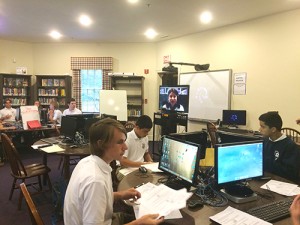
BERLIN – Corneal ulcers. Dead gut. Bat bites.
They represent just a few of the medical challenges Worcester Preparatory School’s would-be doctors faced in a unique simulation last week. Through a program from the Challenger Learning Center, AP Biology students at the school were able to take part in a simulated medical mission trip down the Amazon River.
“It’s great critical thinking and a terrific learning opportunity,” said Celeste Bunting, head of the lower school at Worcester Prep. “It’s really empowering the children.”
The AP Biology simulation was the latest of several video conferencing programs hosted this year at Worcester Prep. Thanks to a grant, students in pre-kindergarten through high school have taken part in video conferences. Through these conferences, they have been able to do everything from build robots to study the intricacies of space suits.
Last week, 10th grade students in AP Biology got a glimpse of what it would be like to be a doctor on a mission trip with the CyberSurgeons live simulation program. It tasked students with determining how to treat patients suffering from a variety of diseases and injuries as they took a simulated voyage down the Amazon River.
What started with aerial shots of the terrain over the monitor at the front of the classroom shortly became a high-energy video conference between the students, who were playing the parts of doctors, and the supposed head of the National Institutes of Health. During the video conference, the leader of the health organization, addressed by students as chief medical officer, provided them with instructions and asked for updates on patients throughout the day.
The teenagers, each designated as a diagnostic specialist, med-surg specialist, clinical intervention specialist or case manager, were tasked with treating the patients whose files were coming across their computers.
The students assigned as case managers communicated with the chief medical officer and received patient charts.
Those serving as diagnostic specialists had to look through a database that linked symptoms with possible diagnoses. Med-surg specialists reviewed lab and x-ray results to finalize a diagnosis while students acting as clinical intervention specialists had to review the diagnoses and recommend treatment.
“The ultimate goal was not just to treat them but to get them discharged,” AP Biology teacher Tom Westcott said.
Some of his students treated a man with a dead gut or intestinal ischemia. Others were charged with saving a child whose brain was being eaten by an amoeba that had gone up his nose during a swim. Though the assignments were challenging, afterward nearly half Westcott’s class expressed an interest in medicine.
“It was a lot of fun,” said Sambina Anthony, a sophomore at Worcester Prep. “It was difficult at first but once we got the hang of it, it was fun.”
While this year’s video conferencing programs were funded by a grant, Bunting said they had proven so valuable to students that school officials were planning to make them a regular purchase in the future.
